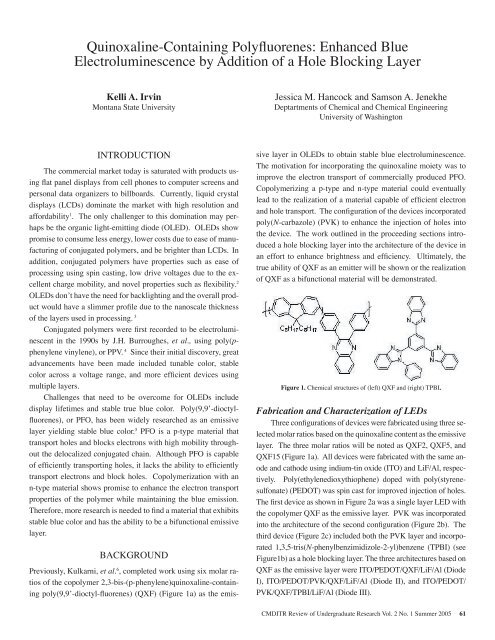Student Project Abstracts 2005 - Pluto - University of Washington
Student Project Abstracts 2005 - Pluto - University of Washington
Student Project Abstracts 2005 - Pluto - University of Washington
Create successful ePaper yourself
Turn your PDF publications into a flip-book with our unique Google optimized e-Paper software.
Quinoxaline-Containing Polyfluorenes: Enhanced BlueElectroluminescence by Addition <strong>of</strong> a Hole Blocking LayerKelli A. IrvinMontana State <strong>University</strong>Jessica M. Hancock and Samson A. JenekheDeptartments <strong>of</strong> Chemical and Chemical Engineering<strong>University</strong> <strong>of</strong> <strong>Washington</strong>INTRODUCTIONThe commercial market today is saturated with products usingflat panel displays from cell phones to computer screens andpersonal data organizers to billboards. Currently, liquid crystaldisplays (LCDs) dominate the market with high resolution andaffordability 1 . The only challenger to this domination may perhapsbe the organic light-emitting diode (OLED). OLEDs showpromise to consume less energy, lower costs due to ease <strong>of</strong> manufacturing<strong>of</strong> conjugated polymers, and be brighter than LCDs. Inaddition, conjugated polymers have properties such as ease <strong>of</strong>processing using spin casting, low drive voltages due to the excellentcharge mobility, and novel properties such as flexibility. 2OLEDs don’t have the need for backlighting and the overall productwould have a slimmer pr<strong>of</strong>ile due to the nanoscale thickness<strong>of</strong> the layers used in processing. 3Conjugated polymers were first recorded to be electroluminescentin the 1990s by J.H. Burroughes, et al., using poly(pphenylenevinylene), or PPV. 4 Since their initial discovery, greatadvancements have been made included tunable color, stablecolor across a voltage range, and more efficient devices usingmultiple layers.Challenges that need to be overcome for OLEDs includedisplay lifetimes and stable true blue color. Poly(9,9’-dioctylfluorenes),or PFO, has been widely researched as an emissivelayer yielding stable blue color. 5 PFO is a p-type material thattransport holes and blocks electrons with high mobility throughoutthe delocalized conjugated chain. Although PFO is capable<strong>of</strong> efficiently transporting holes, it lacks the ability to efficientlytransport electrons and block holes. Copolymerization with ann-type material shows promise to enhance the electron transportproperties <strong>of</strong> the polymer while maintaining the blue emission.Therefore, more research is needed to find a material that exhibitsstable blue color and has the ability to be a bifunctional emissivelayer.BACKGROUNDPreviously, Kulkarni, et al. 6 , completed work using six molar ratios<strong>of</strong> the copolymer 2,3-bis-(p-phenylene)quinoxaline-containingpoly(9,9’-dioctyl-fluorenes) (QXF) (Figure 1a) as the emissivelayer in OLEDs to obtain stable blue electroluminescence.The motivation for incorporating the quinoxaline moiety was toimprove the electron transport <strong>of</strong> commercially produced PFO.Copolymerizing a p-type and n-type material could eventuallylead to the realization <strong>of</strong> a material capable <strong>of</strong> efficient electronand hole transport. The configuration <strong>of</strong> the devices incorporatedpoly(N-carbazole) (PVK) to enhance the injection <strong>of</strong> holes intothe device. The work outlined in the proceeding sections introduceda hole blocking layer into the architecture <strong>of</strong> the device inan effort to enhance brightness and efficiency. Ultimately, thetrue ability <strong>of</strong> QXF as an emitter will be shown or the realization<strong>of</strong> QXF as a bifunctional material will be demonstrated.Figure 1. Chemical structures <strong>of</strong> (left) QXF and (right) TPBI.Fabrication and Characterization <strong>of</strong> LEDsThree configurations <strong>of</strong> devices were fabricated using three selectedmolar ratios based on the quinoxaline content as the emissivelayer. The three molar ratios will be noted as QXF2, QXF5, andQXF15 (Figure 1a). All devices were fabricated with the same anodeand cathode using indium-tin oxide (ITO) and LiF/Al, respectively.Poly(ethylenedioxythiophene) doped with poly(styrenesulfonate)(PEDOT) was spin cast for improved injection <strong>of</strong> holes.The first device as shown in Figure 2a was a single layer LED withthe copolymer QXF as the emissive layer. PVK was incorporatedinto the architecture <strong>of</strong> the second configuration (Figure 2b). Thethird device (Figure 2c) included both the PVK layer and incorporated1,3,5-tris(N-phenylbenzimidizole-2-yl)benzene (TPBI) (seeFigure1b) as a hole blocking layer. The three architectures based onQXF as the emissive layer were ITO/PEDOT/QXF/LiF/Al (DiodeI), ITO/PEDOT/PVK/QXF/LiF/Al (Diode II), and ITO/PEDOT/PVK/QXF/TPBI/LiF/Al (Diode III).CMDITR Review <strong>of</strong> Undergraduate Research Vol. 2 No. 1 Summer <strong>2005</strong> 61




